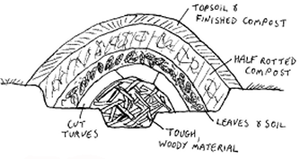
The German (or 'Magic') mound composting method is a good way of dealing with excess amounts of woody garden wastes, e.g., prunings, hedge clippings, brassica stems, brashwood, etc.
In summary, the technique involves digging a circular trench about 1' deep and 5' wide, in the centre of which is dug another 1' deep hole into which the rough material is piled. Turves are then stacked face down onto this pile, then layers of compost, well rotted leaves, manure, etc. are added. The layers gradually break down slowly releasing nutrients and creating rich humus over four or five years; this is ideal for growing hungry crops such as courgettes or strawberries.
See also[edit | edit source]
- Container composting
- Leaf mold
- High fibre composting
- Worm compost
- Spent mushroom compost
- Sheet composting